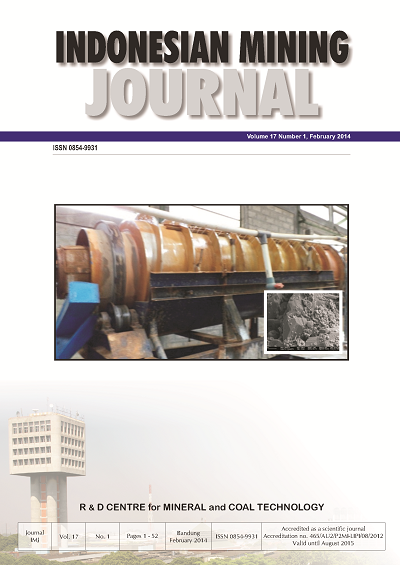ECONOMIC FEASIBILITY ANALYSES OF COAL- BASED ACTIVATED CARBON PLANT IN INDONESIA
DOI:
https://doi.org/10.30556/imj.Vol17.No1.2014.339Keywords:
coal, activated carbon, economic feasibility, commercial plantAbstract
Technology to make activated carbon from coal has been developed from laboratory to pilot plant scales with capacity of 1 ton/day. The results of previous experiments showed that the quality of coal activated carbon has complied with the standard of quality activated carbon from coconut shell (SNI). In addition, the result of coal utilization process showed that activated carbon can be used for water purification on hatchery, and waste water treatment in textiles and rubber industries. Although the technology and the quality have been reached, but for the production it still needs economic feasibility analysis. Economic feasibility analysis is necessary for coal- based activated carbon plant at commercial scale by giving an indication about economic value of the project. The indicators used in the analysis are Net Present Value (NPV), Return on Investment (ROI), Internal Rate of Return (IRR) and Payback Period. Calculation of financial indicators for the activated carbon project produced Rp 49.17 billion NPV, 50% ROI, 68,25% IRR and 1 year 4 months Payback Period. Based on that calculation, it can be concluded that the coal-based activated carbon plant would be economically feasible under certain operational scenarios. This study is expected to become an economic reference material and can attract inves- tors to construct the commercial plant.
References
Anonymous, 2009. Law No. 4 of 2009 on Mineral and Coal Mining, Jakarta.
Anonymous, 2010. Government Regulation No. 23 : Operations Implementation of Mineral and Coal, Jakarta.
Anonymous, 2013a. Level Coupon Bonds of Bank Indonesia, http://www .bi.go.id/web/id/Moneter2 / Interest Rate + / + State Bonds /.
Anonymous, 2013b. Market of Activated Carbon, Co- conut Market Information Center, http://www.coconutmic.com/en/component/con- tent/article/50-research-articles/ 172-market-of- activated-carbon.
Campbell, Q.P., Burnt J.R., Kasaini, H., Kruger, D.J, 2012. The Preparation of activated carbon from South African coal. The Journal of The Southern African Institute of Mining and Metallurgy, vol. 112, p. 37-44.
Crundwell, FK, 2008. Finance for engineers. Springer- Verlag London Limited, England.
Haming, M., and Basalamah, S., 2010. Studi kelayakan investasi proyek dan bisnis. Bumi Aksara, Jakarta, 668 p.
Hsu,L. and Teng., H. 2000, Influence of different chemical reagents on the preparation of activated carbons from bituminous coal. Fuel Processing Technology, vol. 64, p. 155–166.
Lorenc-G, E., Gryglewicz, G. and Gryglewicz, S. 2004. Development of mesoporosity in activated carbons via coal modification using Ca- and Fe-exchange. Microporous and Mesoporous Materials, vol. 76, 2004. p 193-201.
Monika, I. and Suprapto, S., 2011. Production of acti- vated carbon from subbituminous coal using rotary kiln and cyclone burner. Indonesian Mining Journal, vol 14 number 1, February, p 30-37.
UBS Investment Research, 2006. Indonesia Analyser, UBS, p 3, 26.
Umar, H., 2001. Studi kelayakan bisnis Edisi 2. Gra- media Pustaka Utama, Jakarta, 301 p.
Paul, P.J., 2002. Value added products from gasifica- tion activated carbon. Combustion Gasification and Propulsion Laboratory, Department of Aero- space Engineering, Indian Institute of Science, Bangalore.
Downloads
Issue
Section
License
Indonesian Mining Journal provides immediate open access to its content on the principle that making research freely available to the public to supports a greater global exchange of knowledge.

This work is licensed under a Creative Commons Attribution-NonCommercial 4.0 International License.













